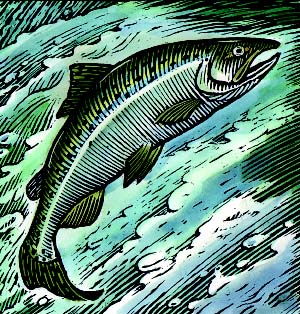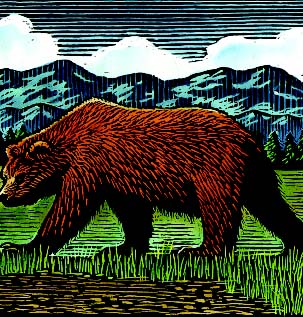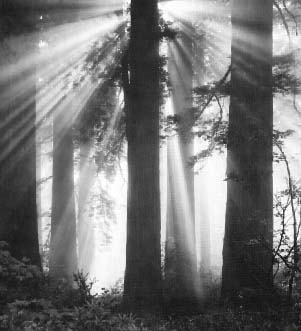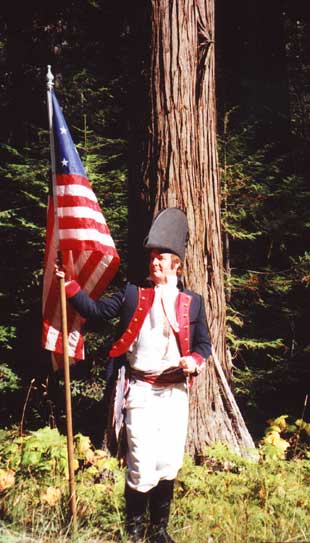|
Protecting
Wild America
|

|
|
|
Sierra
Club launches project to save, restore Lewis and
Clark trail
By
Patrick McMahon, USA Today
SEATTLE
- The Sierra Club is launching an ambitious
five-year campaign today to protect and restore
millions of acres of wilderness along the route
explorers Meriwether Lewis and William Clark
traveled through the West almost 200 years
ago.
The
nation's oldest and largest grass-roots
environmental organization has identified 34 sites
in eight states for attention as it kicks off a
multimillion-dollar plan called "Wild America:
Protecting the Legacy of Lewis and
Clark."
"There's
a whole lot gone and a whole lot left," Sierra
Executive Director Carl Pope said. "This is the
premier land preservation and restoration
opportunity that Americans are going to have in the
first decade of the 21st century."
The
project comes as the bicentennial of Lewis and
Clark's 1804-06 expedition approaches. Their
journey is being celebrated in the media and in
events from St. Louis to Oregon, where they became
this nation's first cross-country travelers to
glimpse the Pacific Ocean.
Thursday
night, the History Channel premieres an hour-long
documentary on the Missouri River with Stephen
Ambrose, author of the Lewis and Clark biography
"Undaunted Courage."
"Considering
the trip was as exciting as a trip to the moon 200
years ago, every small town along the route has
come down with bicentennial fever," Idaho lawyer
Tom Keefe said. His hometown, Kamiah, was where the
expedition camped for nearly a month after the Nez
Perce Indians saved the explorers from
starvation.
"This
is the premier land preservation and
restoration opportunity that Americans are
going to have in the first decade of the
21st century."
--
Carl Pope, executive director of the
Sierra Club
|
"There's
likely to be millions of people traveling the route
in the next decade," said John McCarthy,
conservation director of the Idaho Conservation
League, "and to the extent we have some legacy
left, the time is right" for the Sierra Club
effort.
Idaho,
which gets substantial attention in the Sierra Club
plan, "has some of the greatest unprotected wild
lands in the lower 48 states that look just the way
they did when Lewis and Clark came through here,"
McCarthy said. However, "every year, we're losing
hundreds of acres to development."
|
Jim
Young, a Sierra Club official in Seattle and a
co-author of the plan, said it seeks to permanently
shield undeveloped lands such as the Beartooth
Plateau in Wyoming, the Bitterroot Range along the
Idaho-Montana border and the Dark Divide roadless
area in Washington state.
The
Sierra Club also wants to ban road building and
logging in roadless areas, to protect grizzly bear,
salmon and bison habitats, to keep off-road
vehicles out of sensitive areas and to bar oil and
gas leasing in pristine areas. The club also
proposes to remove earthen sections of four dams on
the lower Snake River and to protect prairie dogs
in South Dakota's Buffalo Gap National
Grassland.
It
wants a federal wilderness designation for the
Little Missouri Badlands in North Dakota to protect
the area from oil and gas development. It wants the
same designation for the Lemhi Mountains in Idaho,
home of Lewis and Clark's Shoshone guide Sacagawea.
It also wants Tillamook State Forest in Oregon, now
earmarked for logging, to be saved as a state park.
In Nebraska, it seeks greater water quality
protection statewide and better management of the
Niobrara River by the National Park
Service.
New
laws and regulations are needed to accomplish much
of what the Sierra Club has outlined. Another key
part of the plan is to generate public support for
a proposal President Clinton recently announced to
protect roadless areas in national forests, Young
said.
The
plan drew a caustic response from some.
"The
wilderness advocates come up with one hare-brained
scheme after another to lock up our public lands,"
says Clark Collins, executive director of the Blue
Ribbon Commission in Pocatello, Idaho. "Wilderness
advocates would lock out present-day explorers who
want to use mountain bikes and off-road vehicles to
explore our back country."
It
is not known what the project would cost
corporations or individual states.
The
plan calls for elimination of some revenue-making
activity such as lumbering and oil and gas
exploration and would stymie some recreational
development.
USA
Today, November 17, 1999. Copyright 1999.
USA TODAY. Reprinted with
permission.
|
|
|

©
Sierra Club
|

©
Sierra Club
|
|
|
Sierra
Club wants Lolo Trail protected
Organization
says logging would be tragic
By
Mike McLean, Staff writer
THE
LOLO TRAIL -- A 60-mile stretch of the route of
Lewis and Clark in Idaho is the centerpiece of a
major drive by the Sierra Club to protect wildlands
in the West.
The
five-year campaign, Protecting the Legacy of Lewis
and Clark, is already drawing skepticism over the
major environmental actions it endorses.
"Americans
generally have very little sense of their
own history, but they are very good at
commemorating events. The Lewis and Clark
bicentennial is a huge event for this
country."
|
But
club members expect it to gain momentum as it
coincides with the bicentennial of the historic
expedition, which began when the Corps of Discovery
set out from St. Louis on May 14, 1804.
"This
is our nation's story," said John Osborn, during a
Sierra Club sponsored tour of the Lochsa country
and the Lolo Trail in the Clearwater National
Forest.
The
explorers traversed the ridge-line trail on their
way west in September 1805 and on their return trip
in June 1806.
"In
this great national museum, the last wilderness
section of the entire trail is the Lochsa River
country," said Osborn, a regional environmental
leader, author and Spokane physician. "It's remote,
it's wild, it's incredible and it's a real national
treasure."
Two
centuries after Lewis and Clark, the world is a
different place, he said, referring to the emerging
series of difficult environmental
problems.
"Americans
generally have very little sense of their own
history, but they are very good at commemorating
events. The Lewis and Clark bicentennial is a huge
event for this country," Osborn said. "We can
eulogize what has been lost and perhaps point
fingers in the process, or we can work very hard to
protect what's left and to try to save the salmon,
the cutthroat, the grizzly bear and the wolf from
slipping into extinction."
"[C]ommemorate
the bicentennial in part by bypassing
those dams, honoring the treaties and
saving the salmon."
|
The
Sierra Club endorses proposals to breach four Lower
Snake River dams. Osborn said a large body of
scientific evidence indicates dam breaching would
be the last chance for wild salmon and steelhead
populations to recover in the Lochsa among other
rivers.
"When
Lewis and Clark crossed the Continental Divide and
stepped into the Columbia River ecosystem, they
were walking into a river of life in which an
estimated 16 million salmon and steelhead swam
upriver," he said.
|
America's
Native Forests
1620
 2000 2000

U.S.
Forest Service photo
|
|
"One
of the reasons they came down here to the Lochsa
was in search of that fish to keep them alive. It
was ultimately the fish and the camas root that
saved their lives when they fell into the hands of
the Nez Perce Tribe."
In
the last century, the richest salmon fishery on
earth has been transformed into the largest
hydropower system, in some cases directly
overriding tribal fishing treaties.
"In
many ways it's a very sad part of the history of
the region," Osborn said. "I think the opportunity
presents itself to commemorate the bicentennial in
part by bypassing those dams, honoring the treaties
and saving the salmon."
Len
Broberg, University of Montana environmental
studies instructor and Sierra Club volunteer, said
the Lochsa country is one of the last places were
visitors can see the landscape much as Lewis and
Clark saw it.
"This
is the center of a wildlands complex," Broberg
added. "This is a biodiversity hot spot. There are
a lot of rare animals and endemic
plants."
The
Lochsa Wild and Scenic River corridor, which is
sandwiched between the Selway Bitterroot Wilderness
to the south and the Great Burn area to the north,
is the last best place for grizzly bears, Broberg
said.
"It
makes sense that grizzlies should be here," he
said.
While
the largest land mammal in the lower 48 states may
eventually find its way to the Lochsa, the Sierra
Club supports transplanting grizzlies from healthy
populations in Canada rather than from Yellowstone,
where they are still on the Endangered Species
List.
In
addition, the club supports Northern Rockies
Ecosystem proposals, which aim to connect separate
grizzly bear populations in Yellowstone National
Park, central Idaho, Cabinet-Yaak and Glacier
National Park as well as lower British Columbia and
Alberta in Canada to allow more genetic
diversity.
"We
think it's possible if we take the right steps
soon," Broberg said.
Because
grizzly bears are considered an indicator species,
protection of land for grizzlies will also benefit
other sensitive species such as lynx and
wolverines.
The
club, which opposes all logging on public land, is
one of the biggest boosters of the Clinton
administration's proposed roadless policy that
would protect 40-60 million acres nationally from
road building and timber harvesting.
The
club specifically wants the Forest Service to
withdraw plans for timber harvest on the Lochsa
Face.
|
Clearwater
National Forest officials are rewriting sales that
originally included a timber harvest of 75 million
board feet over a period of five to 10 years in the
Lochsa country.
"This
is spread over a large area and a large period of
time," said Dennis Elliott, CNF deputy ranger. "I
would guess we're a year and a half to two years
away from anything going on the ground."
Some
of the projects would be visible from the Lolo
Trail.
"Any
timber harvest you see would be set up to emulate
natural conditions," Elliott said.
"What
I would expect to see would be large acreages with
what we could call structure left afterward. Just
like you would see after a fire."
Two-thirds
of the project involve ecosystem
burning.
"Some
of that would probably come right up to the Lolo
Motorway," Elliott said.
Not
everyone is delighted by the Sierra Club's
campaign.
"the
last wilderness section of the entire
trail is the Lochsa River country. It's
remote, it's wild, it's incredible and
it's a real national
treasure."
|
Alex
Irby, a Konkoville Lumber resource manager who grew
up in the Clearwater area, said the Sierra Club
should let the Forest Service manage the
resources.
About
70 percent of the land in the Clearwater Region is
federally managed.
"Coming
out against all logging is foolhardy," said Irby,
an Idaho Fish and Game commissioner who enjoys the
trail. "When they came out with that stance, it
alienated some of their best
supporters."
He
said there is no longer excessive logging in the
region.
"The
Forest Service just hasn't been selling any timber
here for five to 10 years. This past year, they
sold a little under 2 million feet on a forest
that's capable of growing close to 400 million a
year," Irby said. "Most of that was firewood and
fence posts."
Coeur
d'Alene Press, October 3, 2000. Reprinted with
permission of the Coeur d'Alene
Press
|
|
|
36,647
Miles of Roads and Trails
By
Chris Ehlers
While
the US Forest Service is busy gathering public
comment concerning the proposal to exclude the
building of new roads on 40 million acres of public
land in the U.S., with 8 million of those acres in
Idaho, one environmentalist group says more than
enough roads already exist for motorized use. Too
many, in fact, according to the Sierra
Club.
135,000
miles of roads and 26,000 miles of trails
are open to dirt bikes and ATVs across
eight Western states.
|
"This
discrepancy is grossly unfair," said Roger Singer
with the Middle Snake Group of the Sierra Club in
Boise. "Idaho's growing recreation need is greatest
for more non-motorized use, like hiking and
horseback trails, not more dirtbikes.
"There
are already 36,647 miles of National Forest roads
and motorized trails in Idaho," Singer
added.
"Only
a fifth of the landscape first experienced
by Lewis and Clark two hundred years ago
on foot and on horseback is still
wild,"
--
jonathan stoke
|
"Non-motorized
use is being crowded out for a privileged
few."
The
fuel for the Sierra Club's fire was an internal
report with data gathered by Sierra Club staff and
released last week that concluded that motorized
vehicles have been given access to National Forest
trails out of proportion to their numbers. The
report found 135,000 miles of roads and 26,000
miles of trails are open to dirt bikes and ATVs
across eight Western states.
|
The
result of the motorization of forest backcountry is
that hikers, backpackers and horse riders who seek
to escape machines during their trips, according to
Sierra Club officials, are crowded onto a limited
number of trails -- 112 per mile each year in
Idaho. On the other hand, the smaller number of
dirt bike and ATV users is spread out across a
larger area -- 36 riders per mile annually.
"Only
a fifth of the landscape first experienced by Lewis
and Clark two hundred years ago on foot and on
horseback is still wild," said jonathan stoke of
the Sierra Club. "Much of what remains is without
lasting protection, threatened by dirtbikes and
ATVs."
"Trail
use by dirt bikes and ATVs spooks
wildlife, creates erosion, introduces
invasive weeds, and hounds out other
hikers and horse riders who can't stand
the noise, stench and damage the machines
cause to the trails."
--
Mark Lawler
|
Ditto,
said Mark Lawler with the Sierra Club's Cascade
Chapter in Washington.
"While
ever increasing numbers of hikers have been crowded
into the backcountry, the US Forest Service has
happily spent huge amounts of money to "'improve'
trails for dirt bikes and ATVs," Lawler said.
"Trail use by dirt bikes and ATVs spooks wildlife,
creates erosion, introduces invasive weeds, and
hounds out other hikers and horse riders who can't
stand the noise, stench and damage the machines
cause to the trails."
Wood
River Journal (Sun Valley, Ketchum and Hailey,
Idaho), June 21, 2000, Reprinted with permission of
the Wood River Journal.
|
|
|
Shattered
Solitude And Eroded Habitat
The
motorization of the Lands of Lewis and
Clark
Mark
Lawler, Sierra Club, June 2000.
"The
American West has been utterly transformed in the
two centuries since first documented by Lewis and
Clark. We continue to lose wildlands at a rapid
pace: it is estimated that Washington state has
lost an average of a quarter-million acres a year
over the past century and Idaho lost a million
acres of wildlands on National Forests in the ten
years before 1995."
|
"This
report [shows] that on the whole, many more
opportunities for recreation on motorized trails
and roads are available to ORV riders than are
available to the far greater numbers of hikers and
horse riders. There are enough open roads on the
region's National Forests and Grasslands to go
around the Earth five times. Similar discrepancies
occur in winter recreation between snowmobiles and
cross country skiers and snowshoers."
The
mileages given are only for National Forests and
Grassland. State and private lands, plus National
Wildlife Refuges, and even Parks, have additional
miles of roads and ORV routes.
The
full report is available for electronic viewing or
printing at www.sierraclub.org/wildlands/ORV
or by contacting
mark.lawler@sierraclub.org.
|
|
|
About
Sierra Club & Ridgelines
The
Sierra Club's grassroots advocacy has made it
America's most influential environmental
organization. Founded in 1892, we are now more than
700,000 members strong. The Northern Rockies
Chapter covers Idaho and eastern Washington, and is
comprised of five groups: Upper Columbia River,
Palouse, Middle Snake, Sawtooth, and Eastern
Idaho.
Our
Mission is to:
- Explore,
enjoy, and protect the wild places of the
earth;
- Practice
and promote the responsible use of the earth's
ecosystems and resources;
- Educate
and enlist humanity to protect and restore the
quality of the natural and human environment;
and
- Use
all lawful means to carry out these
objectives.
To
find out more about us and our work, visit our web
page www.sierraclub.org.
For more information about the Northern Rockies
Chapter, see www.idaho.sierraclub.org.
A
special thanks to John and Ann Klekas for their
fine work in uncovering the Lewis & Clark
stories from 1805 and 1806.
Quotes
from Bernard DeVoto are from THE JOURNALS OF LEWIS
AND CLARK, edited by Bernard DeVoto. Copyright
© 1953 by Bernard DeVoto, renewed 1981 by Avis
DeVoto. Reproduced by permission of Houghton
Mifflin Company. All rights reserved.
Ridgelines
is the journal of the Northern Rockies Chapter of
the Sierra Club. This is a special Lewis &
Clark commemorative issue, edited by John Osborn;
computer,web, layout and graphic design by
Easy.
Ridgelines
is published by the Northern Rockies Chapter of
the Sierra Club, and is free to all members living
within the geographical area of the chapter. Submit
letters or articles to PO Box 552, Boise, ID
83701.
This
publication is printed on at least 40% recycled
paper with soy based ink. This edition is also on
the web, which helps reduce paper use, and can be
viewed at: www.waterplanet.ws/lewisandclark

www.sierraclub.org
|
NORTHERN
ROCKIES CHAPTER LEADERSHIP DIRECTORY
- Chair
& RCC At Large
- jonathan
stoke*
- jonathan.stoke@juno.com
-
- Vice-Chair,
Membership Chair
- Marty
Marzinelli*
-
- Secretary,
Dave Hedge
- dave.hedge@juno.com
-
- Treasurer,
John Allen
-
- RCC
Delegate, Ron Wise*
- wiser@valley-internet.net
-
- Conservation
Chair & RCC At Large
- John
Osborn*
- john@waterplanet.ws
-
- Council
Delegate, Duane Reynolds*
- wdreynolds@bigfoot.com
-
- RCC
Delegate, Edwina Allen
- edwinaallen@homeinternet.net
-
- Al
Poplawski*
- dial@moscow.com
-
- John
Schmidt*
- jschmidt@srv.net
-
- Hal
Rowe*
- hrowe@kettlerange.org
-
- Bert
Redfern*
- bertilia@juno.com
-
- *
Chapter Executive Committee member
-
- GROUP
CHAIRS
- Upper
Columbia River - Hal Rowe
- hrowe@kettlerange.org
-
- Palouse
- Al Poplawski
- dial@moscow.com
-
- Sawtooth
- Duane Reynolds
- wdreynolds@bigfoot.com
-
- Eastern
Idaho - John Schmidt
- jschmidt@srv.net
-
- Middle
Snake - Scott Larson
- LARSOS@bor1.sd01.k12.id.us
-
- STAFF
- Chase
Davis
- (509)
456-8802
- scnw@icehouse.net
- 10
N Post St, Ste 447, Spokane, WA
92201
-
- Roger
Singer
- (208)
384-1023
- roger.singer@prodigy.net
- PO
Box 552, Boise ID 83701
|
Return
To Lewis & Clark Home Page
|
2000

